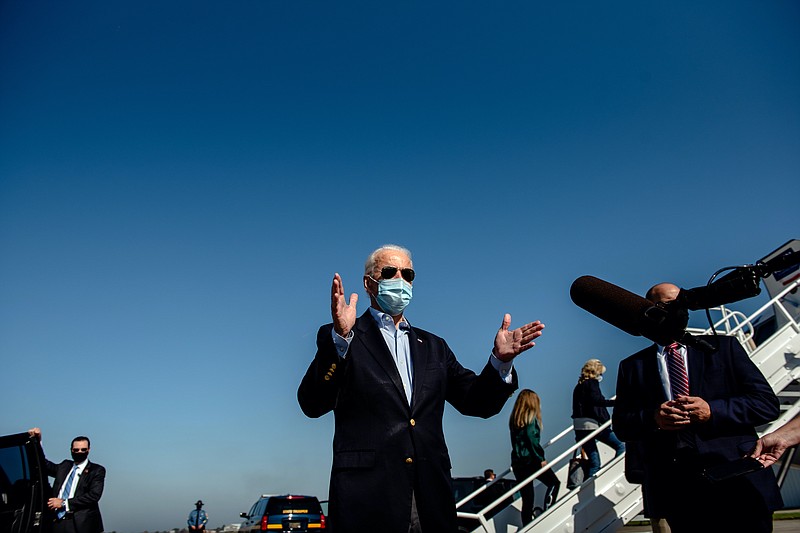Just this week, a Trump-leaning newspaper, the New York Post, featured an opinion column headlined "Biden has absolutely nothing to add when it comes to fighting COVID-19."
The New York Post is both right and wrong.
It's right in that Biden may well indeed have nothing to add, now - except the elected power to implement the plan he began laying out in a January op-ed for USA Today. That plan grew and became more fleshed out the very next month, and now Biden has not just a blueprint but also the team to raise the bar as soon as he is elected and inaugurated.
The New York Post is wrong on almost every other point, especially in falsely asserting that Biden hasn't said what he would do differently or what action a president was supposed to swiftly take that Trump hadn't done.
* Biden, with his Jan. 27 op-ed, handed Trump an early playbook. At that point, there were five confirmed cases in the United States, and the State Department had scheduled an evacuation flight to bring home non-essential American personnel in China and advised Americans against traveling to Hubei province, the epicenter of the outbreak.
Biden wrote: "As president, I will reassert U.S. leadership in global health security [a Barack Obama/Biden-created program, born of lessons in controlling Ebola, intended to lead the U.S. response in the event of a future deadly pandemic]. My policies will always uphold science, not fiction or fearmongering. I will ask Congress to beef up the Public Health Emergency Fund and give me the power to use the Stafford Disaster Relief and Emergency Assistance Act to declare a disaster if an infectious disease threat merits it."
Later that same day, Trump established the COVID-19 Task Force, and on Jan. 31 he declared a public health emergency under the Public Health Service Act.
* As February dawned, Biden already was creating a war-cabinet-in-waiting on the coronavirus pandemic, according to The Washington Post. The Biden campaign sought advice from David Kessler, a former Food and Drug Administration commissioner under Presidents George H.W. Bush and Bill Clinton, as well as Vivek H. Murthy, the surgeon general under President Obama.
Kessler and Murthy, and a growing number of volunteer health experts, have been at work ever since helping Biden draft plans for distributing vaccines and personal protective gear, ramping up testing, offering guidelines for reopening schools and addressing health care disparities.
The build-out began with work Biden and Obama had already done - work that was undone in 2018 by the Trump administration's 2018 budget request that called for draconian cuts to the National Institutes of Health and the Centers for Disease Control and Prevention and scuttled the global health security unit. All of the proposed cuts did not happen because Congress intervened, but in May of 2018 Trump disbanded the global health security program - the deadly pandemic response unit - and dismissed the top White House official in charge of it. What staffers remained after national security adviser John Bolton's "reorganization" were scattered to other government jobs.
* On March 12 of this year, as the COVID-19 pandemic was growing, Biden laid out a detailed 25-plus page plan to mount a public health and economic response to the COVID-19 crisis and prepare for future global health threats. (You can read it here: https://joebiden.com/covid-plan/.
The very next day, Trump issued two more national emergency declarations under both the Stafford Act and the National Emergencies Act.
And on March 18 - the same day Biden called on him yet again to do so - Trump invoked emergency powers with an executive order under the Defense Production Act. On March 19, Trump named the Federal Emergency Management Agency (FEMA) as the lead agency in the COVID-19 emergency response effort, a designation previously held by the Department of Health and Human Services.
Trump's actions, however, collectively allowed the federal government to pass implementation to states. The feds would deliver virus response funds and other assistance to state and local governments in an effort to reduce the spread of the virus, according to the National Conference of State Legislatures.
* The Kaiser Family Foundation at kff.org offers a detailed comparison of Trump pandemic actions vs. Biden pandemic actions and notes that on April 12, Biden issued a plan to reopen America safely, focused on controlling the virus. Four days later, the White House issued reopening "guidelines." On May 11, Biden criticized the White House for presenting a "false choice" between health and the economy, and on Aug. 21 Biden said he would shut down the country again if scientists recommended it.
In September, The Post wrote that Biden's COVID war-cabinet "has laid out a far more muscular federal approach than has Trump." But let's be honest. That's not hard.
Trump's on-paper plans and orders didn't have a chance against Trump's actions.
He never told Americans what he really knew of COVID-19's real dangers and assured journalist Bob Woodward, "I still like playing it down." What's more, Trump complicated his own experts' plans and efforts to help people be safe by calling the virus a hoax and mocking people who wore masks and social distanced.
Can there be any doubt who needs to handle this and any other pandemic?
